|
And the Band Played On
by Bob Brooke
Brightly painted
bejeweled steeds seem to float around, accompanied by a menagerie of
camels, lions, and even dragons. Up and down, round and round they
go, keeping time with the music of a band organ. From about 1900 to
1930, automatic-playing organs were not only the heart of carousels
but the music of the midway at carnivals, circuses, and fairs.
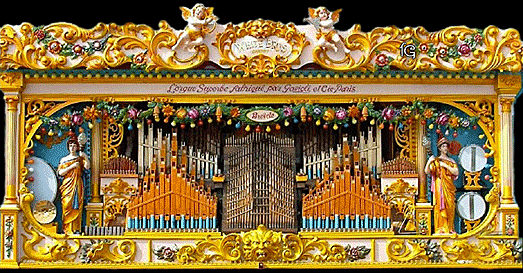
The music of the band
organ recaptures a bygone time, appealing to nostalgia, awakening
memories for adults and creating new ones for children. Long-forgotten
tunes cause memories to flood back—images of carefree days at the old
amusement parks.
The pipes of the band organ duplicate the sounds of French horns,
trumpets, oboes, clarinets, cellos and other instruments. Without a band
organ, the magic of the carousel wouldn’t exist. The only sounds would
be the soft thud as a horse rises and falls or the sound of the gears
meshing overhead. It’s the music that’s the soul of the carousel—the
band organ its heart.
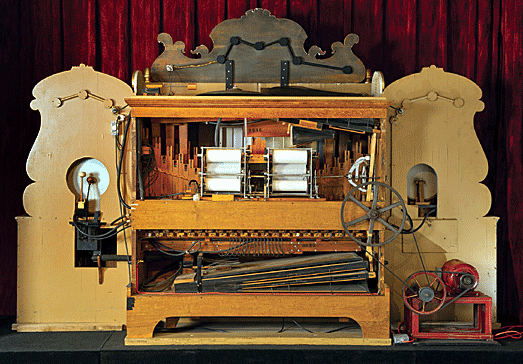
Band organs run on compressed air, pushed through bellows, creating what
many people believe is "the happiest music on earth." A wheel at the
back of the organ turns a crankshaft, operating purnp sticks that drive
a bellows. The resulting air pressure and vacuum create the music when a
gear or pulley on the crankshaft operates the belt or gear. As air
releases into the pipes, music goes forth.
There are three basic types of band organs—those operating on a
cylinder, also called barrel organs, those operating on folded cardboard
books, called book organs, and those operating on paper music rolls.
Each produces a different kind of sound, although they all work on the
same principle, using either compressed air or vacuum.
Band Organ History
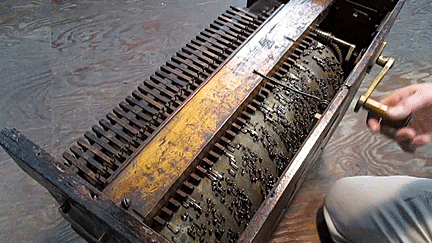 Band
organs originated in Europe. According to historians, automatic
instruments date back as far as the 16th century, when they exclusively
existed for the pleasure of the aristocracy. Band
organs originated in Europe. According to historians, automatic
instruments date back as far as the 16th century, when they exclusively
existed for the pleasure of the aristocracy.
The cylinder or “barrel” organ operated on the design of a music box.
Craftsmen used wood to make the barrels in the 10 century but later
switched to metal. Metal pins or staple-like protrusions helically
arranged on the cylinder opened the valves, creating music.
In the 16th century, craftsmen built large barrel-operated pipe organs,
powered by heavy weights or water, for churches and the music rooms of
royalty and the wealthy. It wasn’t until about 1700 that hand-cranked
organs produced music for the masses. Probably first build in Germany or
Austria, these instruments became popular throughout the Europe.
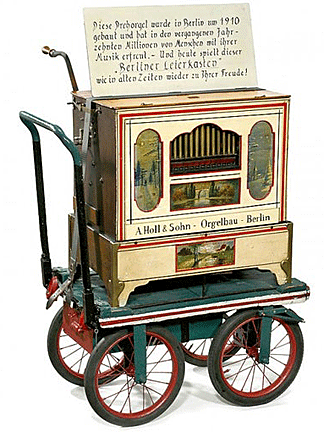 Street
organs were portable, suspended by a leather strap around the operator’s
neck, enabling him to carry it. Some pulled theirs along on a cart. Like
strolling musicians, the organ operators collected coins from their
audience before moving on to the next location. With only about six
songs per cylinder, street organs had a limited repertoire. Street
organs were portable, suspended by a leather strap around the operator’s
neck, enabling him to carry it. Some pulled theirs along on a cart. Like
strolling musicians, the organ operators collected coins from their
audience before moving on to the next location. With only about six
songs per cylinder, street organs had a limited repertoire.
Larger versions, known as fairground organs, produced throughout Europe
by Italian, Austrian, Belgian, Dutch, Czechoslovakian, Hungarian,
French, German and English makers, became common additions to fairs.
Some organs included percussion instruments such as bass and snare
drums, and cymbals. Powered by water or steam, the fairground organ
accommodated cylinders with 8 to 10 tunes. After playing a song, the
operator opened a latch and shifted the cylinder right or left, lining
up a different set of pins.
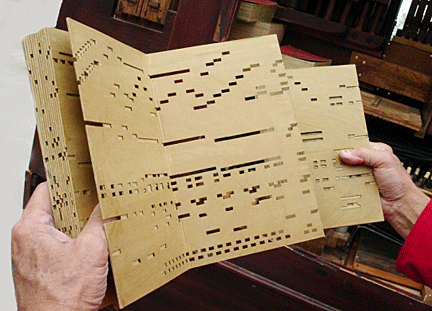 The
next advancement came in 1892, with the invention of the key frame by
Anselme Gavioli. This device, which gave birth to the book organ, played
music punched onto stacked, folded cardboard. There are two kinds of
book organs—key and keyless. Gavioli's key organs use metal fingers or
tines to reach through the music's rectangular perforations, activating
a pounch-and-valve system. As the key triggers and opens the valve, the
air enables the pipes to produce the notes. The
next advancement came in 1892, with the invention of the key frame by
Anselme Gavioli. This device, which gave birth to the book organ, played
music punched onto stacked, folded cardboard. There are two kinds of
book organs—key and keyless. Gavioli's key organs use metal fingers or
tines to reach through the music's rectangular perforations, activating
a pounch-and-valve system. As the key triggers and opens the valve, the
air enables the pipes to produce the notes.
Other organ manufacturers quickly adopted and modified Gavioli's
invention. Some used the keyless system, which doesn’t involve metal
fingers. The cardboard passes under rollers holding it in place against
the tracker bar.
The tracker bar, usually made of brass, has holes in it. Music scores
for keyless organs have circular perforations. With the music held in
place by a grooved roller, compressed air passes through the holes in
the music and tracker bar, actuating the pneumatics and producing the
sound.
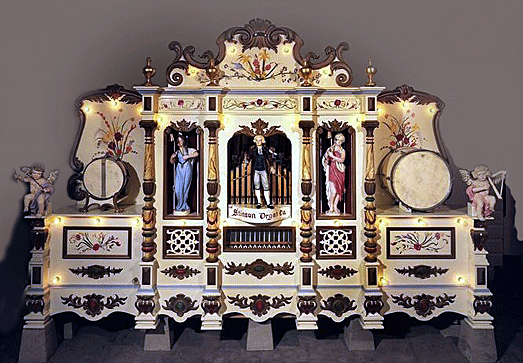
With the heavy wooden
cylinders for the larger organs costing $100 or more, the folded
cardboard books were a welcome change. Book music was durable and
offered greater musical versatility. Because the pneumatics of a book
organ moved faster than the barrel organ, more complicated music with
increased instrumentation was possible. Not only were the books lighter
but easier to store.
However, the book system did have its drawbacks. The music required the
attention of the operator when the yards of music are finally all played
out. And cardboard music, while sturdy and lightweight, couldn't be mass
produced.
The American Contribution
No one knows for certain when the first carousel operated in the United
States. Long a popular amusement in Europe and elsewhere, wooden horses
suspended from chains or affixed to a revolving platform started to
appear in America around the middle of the 19th century.
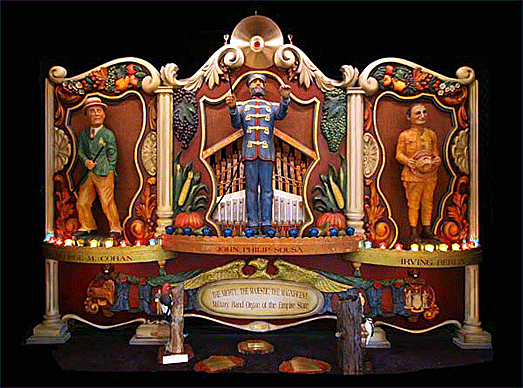
While fairground organs are a European invention, many were imported to
the United States. Founded by James Armitage and Allan Herschell in
1872, the Armitage-Herschell Co. produced steam riding galleries in
their North Tonawanda, New York factories. Powered by a steam boiler,
these carousels featured stationary horses on a circular track, commonly
referred to as "track machines." To cover the sound of the mechanism and
at-tract attention and customers to these portable carousels, Armitage
and Herschell place a band organ at the center.
Eugene De Kleist of Dusseldorf, Germany, brought his Old World organ
expertise to America at the request of Armitage and Herschell in 1893.
De Kleist moved to New York, where he opened the North Tonawanda Barrel
Organ Works, producing barrel organs, barrel-operated pianos and other
instruments specifically for the amusement industry.
The Mighty Wurlitzer
Another German, Rudolph Wurlitzer, emigrated to Cincinnati in 1856.
Initially selling woodwind instruments imported from Germany, he added
drums and percussion instruments during the Civil War. By 1865 he opened
a store in Chicago, and incorporated the Rudolph Wurlitzer Company in
1890.
In 1909 Wurlltzer acquired DeKleist's company and moved its
manufacturing operations to New York State. The firm manufactured most
of the band organs, operated by pinned cylinders and referred to in
Wurlitzer catalogs as military band organs, between 1890 and 1905. From
1905 to 1910 there was a period of transition while paper rolls became
standard after 1910.
The Wurlitzer name dominated the industry. And carousels and other
amusement rides weren't the only customers. Across the country dance
halls, ice rinks, roller rinks, carnivals, circuses, theaters and parks
clamored for Wurliitzer products.
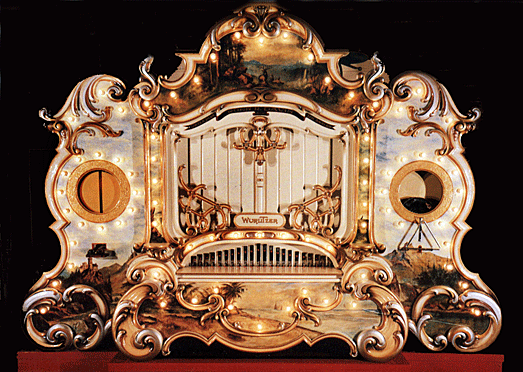
The Style 165 Duplex
Orchestral Organ became one of Wurlitzer's most popular models.
Measuring nearly 8'/z feet high with the facade and nearly 13 feet wide,
it featured a double tracker frame. Never again would the music stop as
a roll rewound. With its 69 keys, the Style 165 featured 18 bass pipes,
20 accompaniment, drums, cymbal, triangle, castanets, and 154 melody
pipes imitating trumpets, violas, flutes, piccolos, violins, bells and
bassoons. In 1916 it sold for $3,500.
To eliminate downtime while music was rewinding, some organs had two
music rolls. Wurlitzer called this their "duplex mechanism." As one roll
rewound, the other played.
At that time, the smallest Wurlitzer band organ, a model 104 measuring
just over 4 feet high and 3˝ feet wide in a plain cabinet cost $550.
This model featured 100 pipes. A model 125, designed for carousels and
rinks, cost $775. Because of the visible brass horns, bass and snare
drums, Wurlitzer called it a military band organ. The Style 125 became
Wurlitzer's most popular brass trumpet organ.
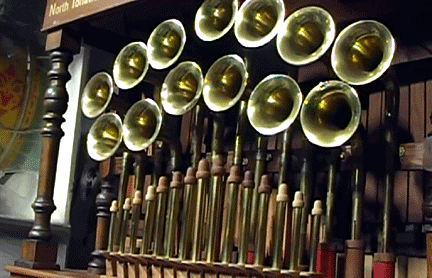 Known
as the "Monster Military Band Organ," Wurlitzeer designed the massive
Style 155 organ especially for skating rinks. Its brass and wooden pipes
filled rinks measuring 10,000 to 20,000 square feet, equaling a band of
12 to 15 musicians. In 1912 this roll-operated organ sold for $3,250. Known
as the "Monster Military Band Organ," Wurlitzeer designed the massive
Style 155 organ especially for skating rinks. Its brass and wooden pipes
filled rinks measuring 10,000 to 20,000 square feet, equaling a band of
12 to 15 musicians. In 1912 this roll-operated organ sold for $3,250.
The largest Wurlitzer organ was the Style 180 or Concert Band Organ—the
company produced only five. Intended for the largest of skating rinks,
the 180 had 480 pipes and measured more than 7 feet high, and more than
7 feet long, with a depth of 4 feet 31/2 inches. Designed to play
special 180 rolls costing $50 each, this organ sold for $8,000 in 1926.
Most of Wurlitzer's automatic instruments such as the coin piano,
theater organ and orchestrions faded in popularity, but not the band
organ. Used by carnivals and circuses throughout the 1930s and 1940s.
Bring Band Organ Music to Life
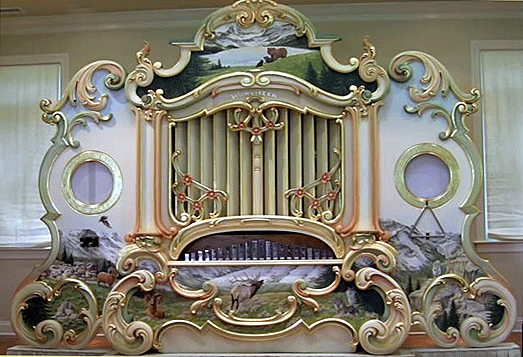
Watch and listen to this beautiful Wurlitzer 165 band organ.
Go behind it and see the workings as it plays. Wurlitzer converted this
original Bruder band organ in 1915 to a Duplex 165 for showman C. W.
Parker. Contracted to carnival operator Harry W. Wright of LaPorte,
Indiana for many years. Discovered derelict in 2006 with missing pipes,
parts, and no facade. Restored to full 165 instrumentation and added 166
instrumentation to augment factory original brass trumpet pipes.
Featuring music of the Little Rascals, Laurel and Hardy composed by
LeRoy Shield and arranged by Rich Olsen. Organ owned by Glenn Thomas,
Belle Mead, New Jersey.
<
Back to More Antique Spotlights
Next Article >
|
